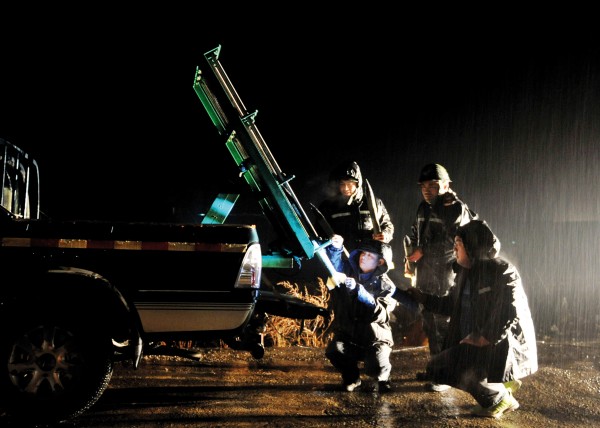A shocking experience
On 28 April 1990 Russell Cullen and Bob Watson were fishing in an aluminium dinghy just offshore from Warkworth.
Late in the afternoon the sky darkened as clouds moved off the land towards them. Suddenly there was a blinding flash and a deafening noise. Instinctively, Bob Watson closed his eyes. When he opened them a split second later there was light dancing along the rim of the dinghy, and Russell had disappeared.
Moving quickly to the bow of the dinghy, Bob looked over and saw his friend a metre underwater. Bob was able to haul Russell back into the dinghy, and tried to revive him as another boat towed them to shore. On the wharf, volunteer firemen worked for 25 minutes trying to resuscitate Russell and almost gave up before they finally got a pulse. Miraculously, Russell survived without brain damage, partly because of his immersion in cold water.
The same thunderstorm that caused the lightning that struck Russell Cullen also caused considerable damage over the land. Hail the size of 50-cent pieces caused thousands of dollars’ worth of damage to horticultural crops, and a small tornado demolished a barn, then speared its timbers through a car and the side of a house.
Another dramatic lightning strike occurred at Hamilton Boys’ High School in October 1987. About 20 boys were sheltering from heavy rain under a tree when a bolt of lightning struck it. Eleven boys were knocked to the ground and one had to be revived with mouth-to-mouth resuscitation. He suffered serious burns to his face, neck and shoulders, and especially to his elbows and the soles of his feet.
In both of these accidents the victims would have died but for the prompt first aid they received. A shepherd mustering near Taihape was less fortunate. Both he and his horse were killed by lightning in December 1986 when there was no one nearby to help.
Another death occurred in December 1984 when a Post Office worker was struck by lightning while repairing telephone lines. He fell four metres from a telephone pole and died instantly A direct hit is not the only danger from lightning. The electrical charge can travel considerable distances through fence wire. telephone wires and even plumbing. A number of people using telephones have been thrown across rooms or burnt when lightning has struck the lines.
A house in Waitara was struck by lightning in April 1992. The flash travelled through the electrical system of the house, destroying almost all the light fittings and sockets, blowing the meter board clean off the wall and then causing an explosion in the gas main under the house. The house was saved from destruction by fire only because of fire-resistant paper underthe floor.
Lightning is the discharge of static electricity that has built up in a thunderstorm cloud. It travels between different parts of the cloud, or between the cloud and the ground. If the lightning is obscured by cloud it is called sheet lightning, but if clearly seen it is called forked lightning.
Static electricity builds up inside clouds in a variety of ways, some not completely understood. Water drops often break up inside clouds and become charged, the larger fragments carrying a positive charge, and the finer spray, negative. The strong updraughts in a cumulonimbus cloud then carry the different sized droplets to different heights, thus increasing the electric field.
Air is normally an insulator. To become a conductor some of the air molecules must become ionised by a strong electric field, such as the one formed in a stormcloud. The electric field below such a cloud can reach as high as 100 volts per centimeter before a lightning discharge.
Lightning travels down towards the ground in steps. Before it gets there a return current comes up from the ground to meet the downstroke. The upward return stroke is the more powerful, and can reach 100,000 amps. It may last only one millionth of a second, but it is this flash that is visible.
The temperature in the upward stroke may reach as high as 30,000°C-more than five times the temperature of the surface of the sun.
Intense heating along the discharge path causes explosive expansion of the air, and this causes thunder. Because the speed of sound is much slower than the speed of light it is normal to see the lightning flash before hearing the thunder. The length of time before the thunder arrives is a measure of how far away the lightning is. A wait of three seconds between seeing the lightning flash and hearing the thunder means the lightning struck one kilometre away.
When lightning passes through something solid like a tree, moisture along its path is instantaneously vapourised, causing the tree to explode. This is how lightning can plough up the ground. In fact, a few years ago when the search was on for kakapo in the mountains of Northwest Nelson, marks made on the ridgetops by lightning were mistaken for kakapo trails.
There are still some unsolved mysteries about lightning. Ball lightning, for example, is a rare and exotic form. Varying in size from a cricket ball to a soccer ball and glowing with the intensity of a domestic light bulb, ball lightning can hang suspended in the air or wander about erratically. Some observers report seeing “blue worms of light” writhing inside the ball. The phenomenon can end quietly or explosively, sometimes causing injury, and, on occasions, death.
There have also been a few reports of lightning striking from a blue sky, as occurred in Arizona in 1966 and felled 30 field workers, killing three of them.
In the United States about 100 people are killed by lightning each year, particularly on golf courses. A few years ago a TV weather forecaster at a major golf tournament was hit by lightning when he was silly enough to put up an umbrella during a thunderstorm.
Lightning tends to discharge through the highest point available. So mountain tops are dangerous places to be in thunderstorms. Sheltering under lone trees is also a foolish idea, as is standing upright in a field.
However, the chance of being hit by lightning is, in fact, very small. There is a far higher chance of being nearby when someone else is hit. So it is a good idea to learn first-aid to be able to revive the victim.
But if you are in the wide open spaces, and a thunderstorm rolls over the horizon, remember, poking an umbrella or a fishing rod into the sky can be a shocking experience.

















